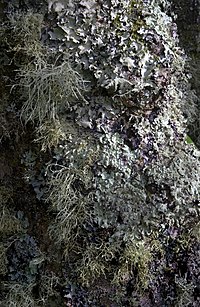
Photo from wikipedia
Research Highlights: Some organisms such as plants and fungi release certain secondary metabolites, generally called allelochemicals, which can influence the organisms around them. Some of the secondary metabolites released by… Click to show full abstract
Research Highlights: Some organisms such as plants and fungi release certain secondary metabolites, generally called allelochemicals, which can influence the organisms around them. Some of the secondary metabolites released by mushrooms may have certain effects on the growth and development of neighboring plants. Background Objectives: The purpose of the present study was to investigate the allelopathic potential of mushrooms in a forest ecosystem. To this end, 289 Japanese mushroom species were collected from the wild and tested using a modified sandwich method, which is a quick and effective bioassay technique. Materials and Methods: The collected specimens were prepared for bioassay as dried samples, and 10 mg/well (10 cm2) was added to a 6-well multidish according to the mycelia biomass, which was estimated at 700−900 kg ha−1 year−1 (7–9 mg 10 cm−2) in coniferous forests. Results: Of the screened mushroom species, 74% inhibited more than 50% of the radicle elongation in lettuce (Lactuca sativa var. Great Lakes 366) seedlings, while the average of all species was 41.1%. This result suggests that wild mushrooms have a significant regulatory effect on lettuce growth. According to our standard deviation variance analysis, 54 out of 289 species showed significant allelopathic activity. Among these species, Xeromphalina tenuipes, Cortinarius violaceus, and Clavaria miyabeana exhibited the strongest growth inhibitory activity, with radicle elongation of 5.1%, 4.3%, and 7.6% of the control, respectively. In contrast, Ischnoderma resinosum stimulated the length of radicle and hypocotyl growth by 30.6% and 42.0%, respectively. These results suggest that these species may play important roles in ecosystems. In addition, the wide range of allelopathic activities observed in mushrooms indicates that various amounts of diverse secondary metabolites from these species are involved in mushroom allelopathy. Conclusions: Our study reveals the importance of evaluating mushroom allelopathy to understand the wider ecological structures within complex ecosystems.
Journal Title: Forests
Year Published: 2018
Link to full text (if available)
Share on Social Media: Sign Up to like & get
recommendations!